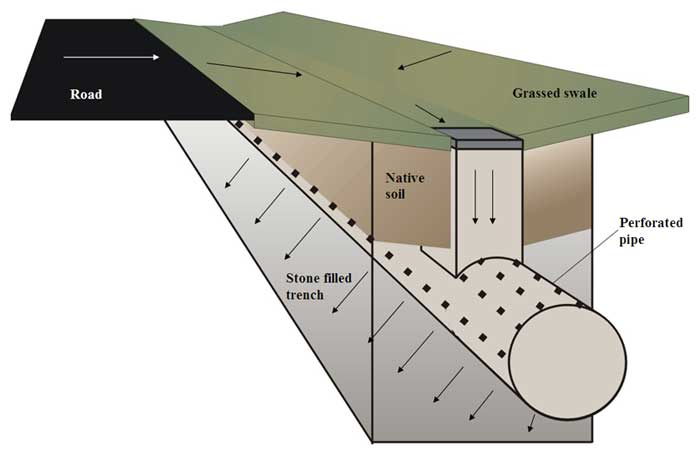Swale and Perforated Pipe Exfiltration System – Ottawa, Ontario
 This evaluation of two swale/perforated pipe exfiltration systems in Ottawa represents one of the few long term investigations into the effectiveness of this type of stormwater management system. The two systems were first evaluated in 1991-1992 by Paul Wisner and Associates, and then again in 1998 and 2006 by J.F. Sabourin and Associates. In 2006, the systems had been operating for 14 to 21 years.
This evaluation of two swale/perforated pipe exfiltration systems in Ottawa represents one of the few long term investigations into the effectiveness of this type of stormwater management system. The two systems were first evaluated in 1991-1992 by Paul Wisner and Associates, and then again in 1998 and 2006 by J.F. Sabourin and Associates. In 2006, the systems had been operating for 14 to 21 years.
For study purposes, the runoff and effluent water quality from the two exfiltration systems (McFarlane and Heart’s Desire) were compared to similar measurements from a conventional sewer system (Amberwood). All three sites were less than 15 ha of predominantly residential land use. Native soils were silty loam till and sandy silt till at the Heart’s Desire and McFarlane sites, respectively.
The exfiltration systems consisted of road side grassed swales below which perforated pipes were embedded in a geotextile lined exfiltration trench of clear stone. Since there was no curb, the catchbasins were located within the grass swale and connected directly to the perforated pipes. Road runoff that did not infiltrate into the swale was conveyed to the catchbasin where it was directed to the perforated pipe and exfiltrated first into the gravel trench and then into the surrounding native soils. When the inflow rate exceeded the exfiltration rate, water was conveyed through the perforated pipe as it would be in a conventional sewer.
After 14 to 21 years of operation without maintenance, the exfiltration systems continue to operate well. Peak flows, runoff volumes and pollutant loads were much lower than from the conventional system. The grassed swale was conveying and infiltrating stormwater as originally intended, and the perforated pipe showed no signs of deterioration or root penetration. For details, download the full report from the sidebar.
